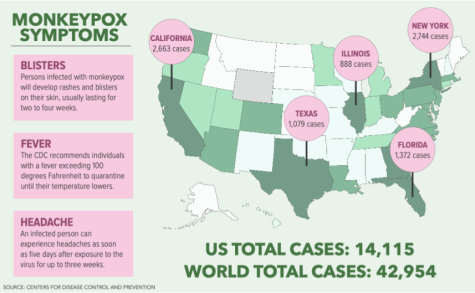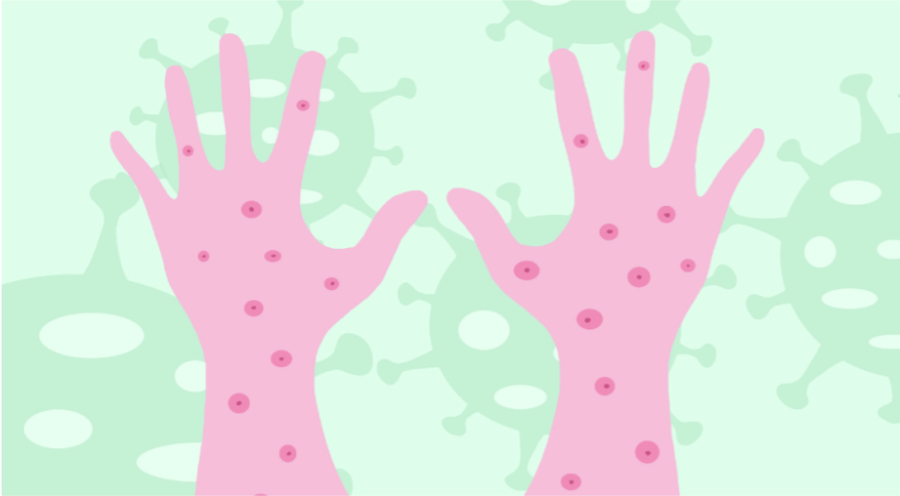Monkeypox: Everything you need to know
The monkeypox virus returns over sixty years after its discovery
An illustration of the monkeypox virus and symptoms. After the first recent monkeypox case’s confirmation in May, the virus has quickly spread to most parts of the world.
The monkeypox virus has reemerged this year with a global outbreak, and with around 15,000 recorded cases in the U.S. and 2,000 in California, the World Health Organization (WHO) has declared it a global emergency on July 23.
The monkeypox virus is classified as an orthopoxvirus, along with similar DNA viruses such as smallpox that are capable of infecting both humans and animals. Although monkeypox was first discovered in humans in 1970 and had since remained mostly endemic to west Africa, the first recent case of the virus was confirmed in the United Kingdom on May 6. When monkeypox quickly spread around the world during the following months, the WHO declared it a global emergency, its highest level of alert.
Individuals infected with monkeypox develop symptoms including rashes, blisters, fevers, exhaustion and headaches within three weeks of being exposed to the virus. Unlike COVID-19, monkeypox has visible effects on those infected. Symptoms can last for between two to four weeks, and the Center for Disease Control and Prevention (CDC) advises infected individuals to quarantine and avoid close contact with others for the full duration of the illness.
Unlike COVID-19, which spreads through the air, monkeypox can only be transmitted through items touched by an infected person or direct contact with an infected person’s blisters, often during sexual intercourse. As a result, the risk of a monkeypox infection in a casual environment is significantly lower. To avoid exposure to the virus, the CDC suggests sanitizing and washing hands frequently as well as limiting skin-to-skin contact with others.
There are currently no reported monkeypox cases at the upper school, so no regular resting for the virus will take place, according to upper school nurse Jennifer Olson.
“Cases should be reported to the campus nurse,” Olson said in an email interview with Harker Aquila. “If someone is actively symptomatic with a rash, they should stay home until cleared by their physician or if they have a diagnosed case, they should stay home until symptoms and rash have resolved.”

Approved in 2019 by the Food and Drug Administration (FDA), the Jynneos monkeypox vaccine is only available to high risk individuals due to the low supply. Studies show that the vaccine produces the same immune response as the older smallpox vaccine last administered in 1972. For those who received it, the smallpox vaccine boosts resistance for the monkeypox virus but does not provide full immunity.
Along with the rise in monkeypox cases, a stigma associated with the LGBTQ+ community has emerged due to the majority of European and North American cases stemming from gay and bisexual relationships, even though anyone can contract the virus from physical contact.
“I recently read an article that used monkeypox as a slur towards the LGBTQ+ community, and I think that there’s definitely going to be a lot of stigma around monkeypox, especially since one of the main ways to contract it is sex,” Women in STEM (WiSTEM) Officer of Communications Ananya Das (10) said. “I think the fact that it’s so visual will only make it worse because … you can’t disguise monkeypox as a different fighter disease.”
Medical Club Vice President Nikhil Devireddy (12) believes the visual confirmation that comes with a monkeypox infection will amplify the already prevalent fear of the virus.
“It’s not something that’s silent but deadly like COVID-19 was,” Nikhil said. “Therefore, I think people will be safer with it, and they’ll take more precautions to ensure their safety because of how visible the symptoms are to the public.”
The circumstances of the pandemic have already prepared the public for staying safe from a deadly disease such as monkeypox, according to Ananya. The WHO has only recently declared monkeypox as a global emergency, and at the current transmission rate, Ananya believes the virus is a long way from evolving into a pandemic.
“I think if this virus existed in a pre-pandemic world, it very much could [spread rapidly], but because of COVID-19, everybody has just learned to stay healthy as almost like a knee-jerk habit,” Ananya said. “That extra caution when it comes to sickness, because of the pandemic we’ve already gone through, will prevent monkeypox from becoming a global pandemic.”

Edward Huang (12) is a co-managing editor for the Winged Post, and this is his fourth year on staff. This year, Edward wants to continue creating unique...

Kinnera Mulam (12) is the co-editor-in-chief of the Winged Post, and this is her fourth year on staff. This year, Kinnera hopes to get to know all the...

Sabrina Zhu (12) is the co-editor-in-chief of the Winged Post, and this is her fourth year on staff. Sabrina hopes to capture more campus life through...


















![“[Building nerf blasters] became this outlet of creativity for me that hasn't been matched by anything else. The process [of] making a build complete to your desire is such a painstakingly difficult process, but I've had to learn from [the skills needed from] soldering to proper painting. There's so many different options for everything, if you think about it, it exists. The best part is [that] if it doesn't exist, you can build it yourself," Ishaan Parate said.](https://harkeraquila.com/wp-content/uploads/2022/08/DSC_8149-900x604.jpg)




![“When I came into high school, I was ready to be a follower. But DECA was a game changer for me. It helped me overcome my fear of public speaking, and it's played such a major role in who I've become today. To be able to successfully lead a chapter of 150 students, an officer team and be one of the upperclassmen I once really admired is something I'm [really] proud of,” Anvitha Tummala ('21) said.](https://harkeraquila.com/wp-content/uploads/2021/07/Screen-Shot-2021-07-25-at-9.50.05-AM-900x594.png)







![“I think getting up in the morning and having a sense of purpose [is exciting]. I think without a certain amount of drive, life is kind of obsolete and mundane, and I think having that every single day is what makes each day unique and kind of makes life exciting,” Neymika Jain (12) said.](https://harkeraquila.com/wp-content/uploads/2017/06/Screen-Shot-2017-06-03-at-4.54.16-PM.png)








![“My slogan is ‘slow feet, don’t eat, and I’m hungry.’ You need to run fast to get where you are–you aren't going to get those championships if you aren't fast,” Angel Cervantes (12) said. “I want to do well in school on my tests and in track and win championships for my team. I live by that, [and] I can do that anywhere: in the classroom or on the field.”](https://harkeraquila.com/wp-content/uploads/2018/06/DSC5146-900x601.jpg)
![“[Volleyball has] taught me how to fall correctly, and another thing it taught is that you don’t have to be the best at something to be good at it. If you just hit the ball in a smart way, then it still scores points and you’re good at it. You could be a background player and still make a much bigger impact on the team than you would think,” Anya Gert (’20) said.](https://harkeraquila.com/wp-content/uploads/2020/06/AnnaGert_JinTuan_HoHPhotoEdited-600x900.jpeg)

![“I'm not nearly there yet, but [my confidence has] definitely been getting better since I was pretty shy and timid coming into Harker my freshman year. I know that there's a lot of people that are really confident in what they do, and I really admire them. Everyone's so driven and that has really pushed me to kind of try to find my own place in high school and be more confident,” Alyssa Huang (’20) said.](https://harkeraquila.com/wp-content/uploads/2020/06/AlyssaHuang_EmilyChen_HoHPhoto-900x749.jpeg)




